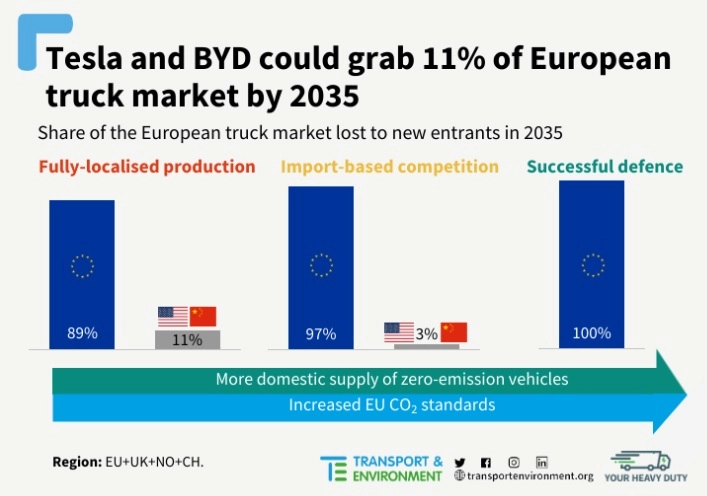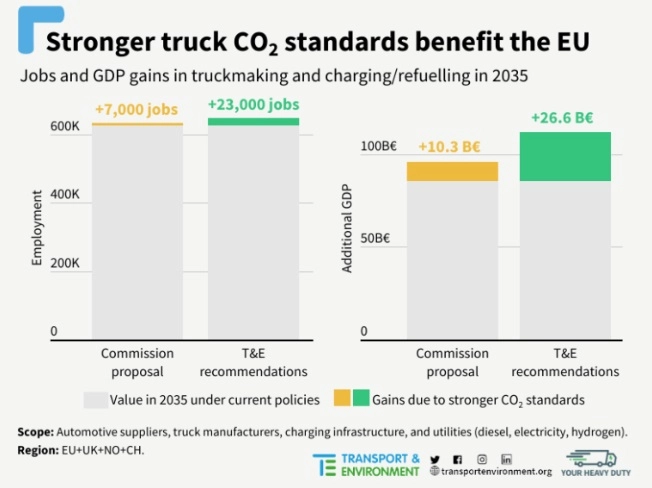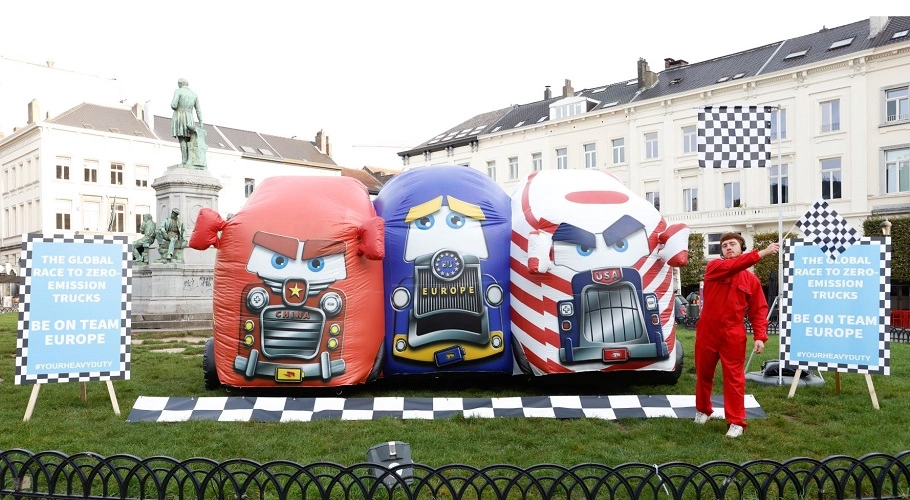Days ago, members of Transport & Environment (T&E) staged a protest in front of the European Parliament as part of their “Your Heavy Duty” campaign.
The aim of this protest was to urge European Union (EU) lawmakers to push domestic industries to increase the supply of electric heavy-duty vehicles and prepare for international competition.
“EU manufacturers are not moving as fast on the transition to zero-emission trucks as their foreign rivals,” explains Priscilla Castro, Transport Campaigner at T&E, to Mobility Portal Europe.
“While Chinese companies and Tesla are investing heavily in truck electrification, the current CO2 standards for heavy-duty vehicles in the EU do not encourage manufacturers to produce more electric trucks,” she adds.

This is why the organization calls on lawmakers to establish “higher” standards, because without ambitious regulations, companies “have no reason to go beyond what is necessary.”
Only in this way can Europe’s domestic market be protected, and its leadership position in the industry maintained.
It’s worth noting that in February 2023, the European Commission proposed the following CO2 reduction targets for all new trucks: 45% by 2030, 65% by 2035, and 90% by 2040.
“They are not ambitious enough to reduce climate emissions and sustain jobs in truck manufacturing and supply chains,” says Castro.
Indeed, T&E recommends that the targets be set at 65% by 2030 and 100% by 2035.
Furthermore, they request that the scope of the regulation be extended to include small trucks and uncertified vehicles, and to exclude all kinds of fuels from the CO2 standards.
“With these regulations, polluting trucks can be off the road in time for the EU’s net-zero emissions goal in 2050,” Castro contends.
“It also means that Europe will be able to defend its industry from international competition and keep up with the expected growing domestic demand,” she adds.
T&E warns truck manufacturers of the risk of losing 11% of the EU market
The lack of “ambitious targets” threatens Europe’s global leadership position in commercial vehicle technology and could even lead to market losses.
This is beginning to occur in the car market, as European car companies that were slow to electrify face increased competition in the EU from Chinese manufacturers.
A study conducted by the Boston Consulting Group (BCG), commissioned by T&E, shows that by 2035, domestic truck manufacturers could lose 11% of sales in the EU market to international electric rivals.
According to T&E, this means that “market shares the size of transport giants like Scania or IVECO could go to big names like BYD and Tesla.”

To prevent this from happening, as sales shift to zero-emission trucks, European companies would have to rapidly increase the supply of this technology.
“They must invest in zero-emission technologies (battery-electric or fuel cell vehicles) and stop wasting time in alternative fuelling for trucks, which are expensive and false climate solutions cannot decarbonise the freight system,” explains Priscilla Castro.
Additionally, Original Equipment Manufacturers (OEMs) should build a strong battery supply chain (in-house production, partnerships, investments), secure raw materials, and move customers towards zero-emission trucks, for example, by offering special services, discounts, and advice.
“Many of the big European manufacturers announced ambitious voluntary targets for 2035-2040, but it is unlikely that they will make the full transition on their own if the legal EU CO2 standards are too low,” acknowledges Castro.
What does the BCG study demonstrate?
The barriers to entry are higher in the truck market than in the car market, and international trade in these products is currently scarce.
However, this can change rapidly if other regions electrify sooner.
According to BCG, demand for zero-emission trucks in the EU will increase to reach 55% of sales by 2030 as prices drop.
But CO2 emissions regulations jeopardize European manufacturers’ ability to meet that demand.
Instead, if stricter emissions reduction targets are set, this would ensure that European workers can reap all the benefits of the shift towards electromobility.

BCG developed a model of the employment impact in the transition to zero-emission trucks and found that the faster the transition, the greater the benefits by 2035.
While with the “unambitious targets” proposed by the European Commission, an additional 7,000 jobs would be created in the sector by 2035, with T&E’s proposals, 23,000 would be created.
Greater ambition in the targets would also increase the contribution of the truck manufacturing sector to the European economy.
While the targets proposed by the European Commission would generate an additional €10 billion in GDP compared to current standards, T&E’s proposals would add €27 billion to GDP.








